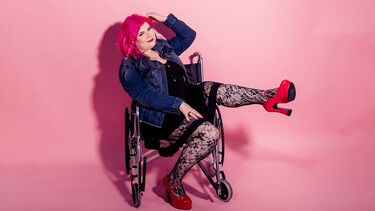
Like many people with an invisible disability, Zoe Simmons believed she was not "disabled enough" to use a mobility aid like a wheelchair or walking stick. When she flipped the script on that belief, she found a new sense of freedom. Here’s her story.
It took me a long time to use mobility aids.
And if there’s one thing I would change about my journey, it’s that I wish I had the courage to use them sooner.
You see, despite accepting that I was disabled (due to fibromyalgia and adenomyosis) I didn’t think I was disabled enough.
I battled with a lot of internalised ableism. For a long time, I felt like mobility aids were only for the elderly or people who literally couldn’t move without them, because that’s all I’d ever seen represented. And all the non-disabled people around me just kept telling me to push through.
As pain and fatigue further consumed my life, my world got a lot smaller. I couldn’t do all the usual things a 20-something could. Heck, just existing was difficult enough. I struggled to walk more than a few minutes without significantly worsening my pain.
And the whole time, I looked longingly at mobility aids, thinking they must be nice.
I saw others with chronic pain using them. While I never judged them, I just couldn’t see myself in the same way. I’d diminish my disabilities, and the impact they had on me – something I think a lot of us are guilty of.
But one day, I just couldn’t. I was going to an art gallery with a friend, and every step felt so incredibly painful. So, I decided to ask if the gallery had any mobility aids available. That was the night I used a wheelchair for the first time.
I can’t even begin to tell you how much of a difference it made – and you probably wouldn’t understand, unless you too know the loving embrace of eased mobility. I was still in pain, but it wasn’t worsened by movement. And instead of hurrying to the closest seat or leaving early, I was able to take my time and actually enjoy myself, despite the judging stares I got for being an ambulatory wheelchair user.
I literally cried tears of happiness that night.
And eventually, I bought my own wheelchair – and a walking stick I use for shorter distances. I use them interchangeably, depending on how I’m feeling and what I’m doing.
A lot of people view me using mobility aids as a bad thing. One person even told me they were so sad to see me in a wheelchair – but it’s not sad for me.
It’s pure joy.
Mobility aids have made my life so much better. And while accessibility is a huge issue, my wheelchair has meant I’ve been able to go shopping with my friends, attend concerts, go on holidays and still see the world, even when I’m in a lot of pain. I’ve even gone out dancing in my wheelchair!
I don’t understand why mobility aids have a bad reputation. I see so many people who suffer, because they feel like they can’t use mobility aids due to the ableist belief that pushing through is somehow superior.
But… what if we just let go of that?
What if we just let people use the things that make their life easier, without judgement and stigma?
What if we just accepted that people use mobility aids for so many different reasons – and that a lot of people live with dynamic and invisible disabilities?
Because mobility aids are freedom machines – and you are allowed to use them.
Always.
About Zoe
Zoe Simmons is a journalist, copywriter, author and disability advocate who works to make the world a better place. Zoe uses her lived experience with mental illness, chronic pain and chronic fatigue to inform her writing, smash stigma, and fight for change. Follow her on Instagram, Twitter, Facebook or LinkedIn, or visit her website for more.
All reasonable steps have been taken to ensure the information created by Jean Hailes Foundation, and published on this website is accurate as at the time of its creation.
© 2024 Jean Hailes Foundation. All rights reserved. This publication may not be reproduced in whole or in part by any means without written permission of the copyright owner. Contact: licensing@jeanhailes.org.au